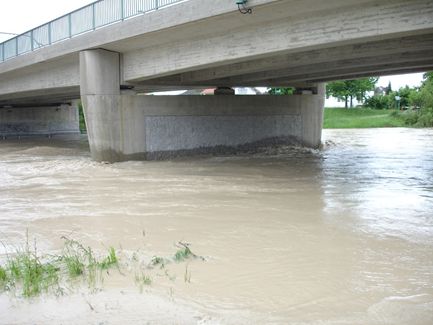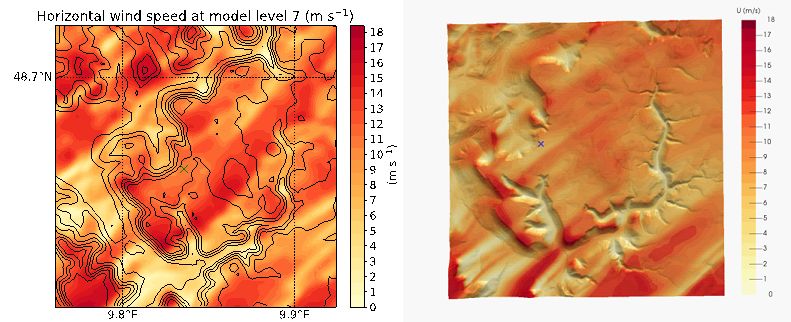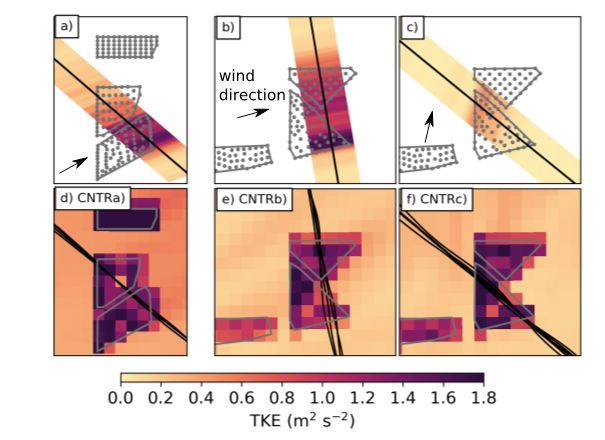Urban Climate - Air Chemistry
.jpg)
Despite all efforts to enhance air quality in urban agglomerations, nitric oxides and ultrafine particles are still a larger problem. Additionally, an increased risk of summer smog episodes with elevated ozone and photo-oxidant concentrations is a consequence of global warming.
The assessment of concentration distributions in cities requires adapted models which resolve street canyons and single buildings due to the high spatial variability of these concentration fields. Therefore, an innovative holistic numerical urban climate model (PALM-4U) has been developed together with many national and international partners in the framework of the BMBF (German ministry of eduction and research) urban climate project [UC]². The contribution of IFU comprises the implementation of air chemistry mechanisms and the testing of the applicability in different German cities (especially Stuttgart). PALM-4U allows for unprecedented simulations of the urban heat island, urban air quality, and urban wind climate with high spatial and temporal resolution.
First results for Berlin and Augsburg demonstrate that the model describes the small-scale chemical processes well, even for larger city quarters. Thus, the model is suited to be used by city planners and city authorities in order to shape better urban living conditions.
Urban Climate - Trees
.jpg)
Global Change makes heat waves more probable which changes the living conditions in cities. Ozone and other air pollutants will exhibit higher concentrations. City trees can counteract this development, because they cool by evaporation and they filter pollutants. Thus, planting and maintenance of trees become one of the most requested methods in urban planning.
The impact of trees on air quality depends on the availability of enough water. Water stress reduces the functionality of trees and other plants. Bad air quality is also a stree factor for trees. Assessments of these stresses is therefore a prerequisite for choosing the right tree species the the planning for their siting and watering.
A tree model which has been further developed at IFU allows for these assessments and can be used by planners and authorities.
Urban Climate - Planning
_rdax_1240x930.jpg)
The majority of mankind is living in urban agglomerations. Thus, resilient planning of cities is necessary in order to diminish the consequences of climate change. This comprises the urban heat island, urban air quality, flash flood risks, and the interaction of urban areas with their atmospheric and biological environment.
Obviously, it is not an easy task to input the findings from meteorology and climate research into planning processes and architectural design ideas. Here, more inter-disciplinary research and cooperation is needed to enhance the necessary knowledge transfer. Furthermore, the political and the regulatory sphere has to be informed about scientific results in order to provoke these two spheres to set suitable boundary conditions for transfering new scientific results into planning and building processes.
Flash Floods

The joint project KARE intends to estimate frequency and intensity of future flash floods and to assess the impacts of climate change on a local level in Upper Bavaria south of Munich. The estimations will be based on data from regional climate models which are currently operated in the framework of CORDEX using the newest CMIP6 data.
The IMK-IFU part of this project builds on these spatially rather coarse data and applies correction methods for local refining (bias correction). The bias correction adapts regional climate data to the local conditions, especially to the local topography and to local wind systems. Different approaches for a multi-variate bias correction will be tested and evaluated. Based on this refined data set, hydraulic flooding simulations will be executed by a subcontractor in order to assess the expected flash flood risks. The known model HYDRO_AS-2D will be adapted for this purpose to the special conditions and requirements of the two pilot communities in the project (Weilheim and Garmisch-Partenkirchen).
The final result will be risk maps for flash floods. These maps will be amended and enhanced during the project together with input from the pilot communities and city planners.
Emeis, S., 2021: Analysis of decadal precipitation changes at the northern edge of theAlps. Meteorol. Z. (Contr. Atm. Sci.), 30, 285-293. DOI: 10.1127/metz/2021/1053
Wind Energy onshore

Wind fields over complex terrain can be calculated with coupled models of different spatial resolution. The coupling is tested according to the following criteria:
- Are there disturbances or artefacts at the edges of the model domains?
- Will meso-scale phenomena be correctly fed into the CDF domain?
- Will the turbulence spectrum be transfered correctly?
- Is mass continuity guaranteed?
Tests were satisfying. The coupling between WRF as meso-scale model and the OPen Foam model as CFD model was successful. The big advantage of the CFD model is the much fines calculation grid which resolves the topography much better. On the other hand the CFD model does not resolve turbulence finer than the WRF model.
A real application over complex terrain is presented in: El Bahlouli, A., D. Leukauf, A. Platis, K. zum Berge, J. Bange, H. Knaus, 2020: Validating CFD Predictions of Flow over an Escarpment Using Ground-Based and Airborne Measurement Devices. Energies 2020, 13(18), 4688; doi: 10.3390/en13184688
Wind Energy offshore

Limiting global warming requires electricity generation from non-fossile resources such as wind energy. While onshore areas for wind farm are very limited in the meantime, offshore wind farms become more frequent. But certain contraints ave to be taken into account. Due to longer wakes (because of the ambient low turbulence intensity) offshore turbines and wind farms have to built further apart. Simulation tools for the wake length are very helpful.
IMK-IFU has evaluated existing wind farm parametrizations in WRF with project partners from the Universities of Tübingen and Braunschweig and Hereon by comparing the simulation results to in situ aircraft measurements. For the first time it could be demonstrated that addition of turbulent kinetic energy within the wind farm parametrization is necessary for certain weather conditions in order to simulate the right wake lengths.
Such simulations are prerequisites for successful and efficient wind farm planning in larger offshore areas. The work which had begun in the project WIPAFF is presently continued in the framework of the follow-up project X-Wakes.

